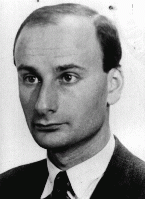
Fritz Silten
Born: February 16, 1904
Berlin, Germany
Fritz was the youngest of two sons born to a Jewish family in the German capital of Berlin. In the late 1920s he earned a doctorate in chemistry and pharmacy. In 1931 he married Ilse Teppich, and in 1933 the couple had a daughter, Gabriele.
1933-39: Fritz worked in his father's pharmacy until 1938, when the Nazis forced them to sell the business for a fraction of its value to an "Aryan" German [Aryanization]. Leaving his parents behind was agonizing, but concern for the safety of his wife and daughter forced Fritz to move in 1938 to Amsterdam. He opened a pharmacy and then sent for Ilse and Gabriele. One year later his mother joined them. His father elected to remain in Berlin.
1940-44: In May 1940 Germany invaded the Netherlands. Fritz was made a member of the German-appointed Jewish council, and tried to use his position to protect his family from deportation by getting their names on "protective lists." But eventually, in June 1943, they were all deported to the Westerbork transit camp. A month later, Fritz's mother committed suicide: she had learned that she was to be sent to Auschwitz. In 1944 Fritz, Ilse and Gabriele were deported to the Theresienstadt ghetto.
Fritz and his family were liberated when Soviet troops took Theresienstadt in May 1945. After the war, Fritz returned to Amsterdam and re-established his pharmacy.